#god damn i miss him he was such an amazing character why kafka
Text
Illustrated a bsd incorrect quote that I found on Tumblr -v-
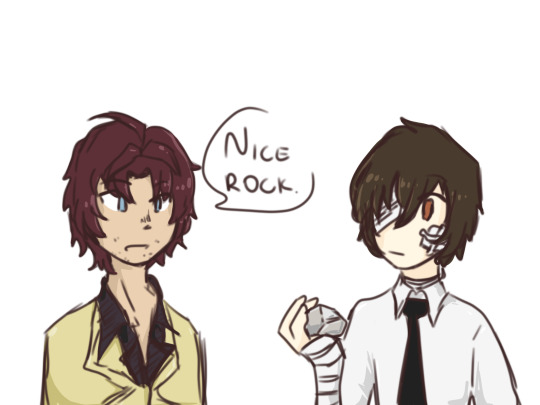
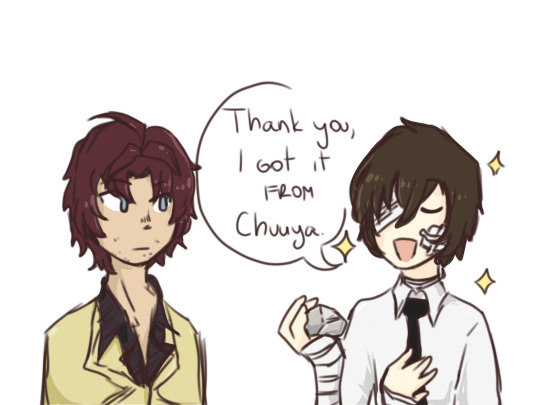

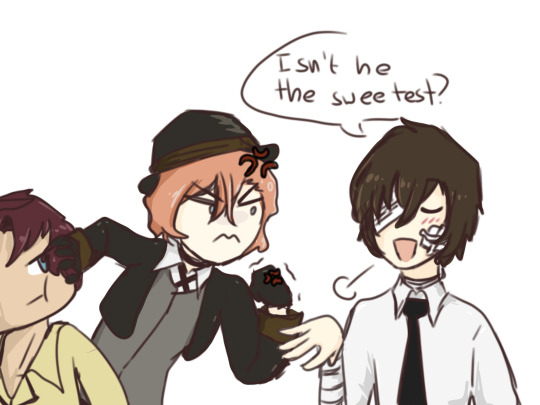
#bungou stray dogs#bsd#bsd fanart#chuuya#chuuya nakahara#nakahara chuuya#dazai osamu#osamu dazai#odasaku#bsd odasaku#oda sakunoske#soukoku#bsd incorrect quotes#dachuu#incorrect quotes#i wish oda was alive#god damn i miss him he was such an amazing character why kafka
561 notes
·
View notes
Text
We live in an age of sequels, of brainless blockbuster movie franchises that follow a simple template: if a movie is wildly successful, just do the same thing again but noisier. As depressing as it is to think that originality is seldom rewarded, occasionally there comes along a sequel that genuinely builds on the original. James Cameron, for instance, has done this twice: Terminator 2 is a more than worthy successor to his own The Terminator, an action film classic (just forget about the ones that came after), and likewise, Aliens is a high point in science-fiction that can proudly stand alongside Ridley Scott’s Alien (again, let’s just ignore the other Alien sequels and prequels).
There have of course been many more misguided follow-ups, and so when it was announced that Ridley Scott wanted to return to the world of Blade Runner, there were more than a few misgivings from fans, especially considering that Scott’s two Alien prequel, Prometheus and Alien: Covenant were, let’s face it, not very good. Having slightly tarnished the universe of one of his classics, surely he wasn’t going to do the same thing with another?
Besides, Blade Runner was a famous box-office flop and only gained cult status after several years and several versions, and even then, people were content to debate the film online. As devoted as its fans are to its vision, nobody was asking for a sequel. Similarly, nobody wants a follow-up to Withnail & I or The Big Lebowski.
Scott’s 1982 classic is a film that doesn’t need a sequel (no film needs a sequel, but some films really don’t need a sequel). It’s a perfect movie that can be enjoyed on many levels: thrilling sci-fi adventure; philosophical examination of humanity; prescient exploration of the increased globalisation and corporatisation of the world that would soon follow.

And yet here we are, 35 years later with Blade Runner 2049. The script is by Hampton Fancher, who co-wrote the original with David Webb Peoples (notable this time around for his absence: more on that later), and Michael Green (Logan, American Gods, Alien: Covenant, and, er, Green Lantern). The studio loved the screenplay, as did everyone else, including Harrison Ford, who declared it one of the best he’d ever read and who agreed to reprise the role of Deckard. From then on, though, the production news was a mixed bag. Scott bowed out as director but stayed on as producer. Ryan Gosling was cast in the lead, which made me wonder if it would be any good (would we get sleepwalky Drive Gosling?) Denis Villeneuve was hired to direct, which I admit got me very excited. Roger Deakins was going to photograph it, which got me very, very excited. Johan Johansson was due to score it – at this point I was all in – but was later replaced by Hans BWAAAAAMMMM Zimmer.
Still, though, I thought, it will be worth seeing, and worth seeing on the big screen. I avoided all trailers and reviews until I’d seen it, which proved difficult because Blade Runner 2049 might just be the most hyped film of the year.
After all the hype, is it any good?
Yes.
And no.
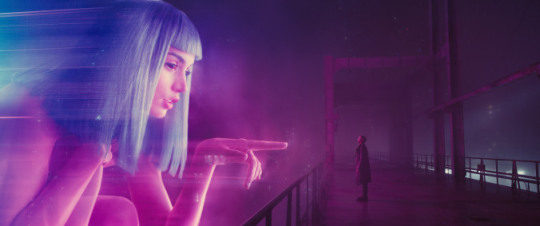
As a visual experience, it’s incredible. The production design is by Dennis Gassner. The city is as grimy and overpopulated as it was in the 1982 film, and the story takes us beyond Los Angeles, filling out the world of Blade Runners and Replicants a fair bit. Deakins’s photography is superb (give the man his damn Oscar finally). The sound design is amazing. The music has wonderful echoes of Vangelis. Gosling is good. Ford hasn’t been this good in ages. Villeneuve’s direction is assured, smooth and filled with his signature moments of dread.
And the script? Well, this is where things get a little hazy.
Some spoilers to follow. You have been warned.
The official synopsis is: A young blade runner’s discovery of a long-buried secret leads him to track down former blade runner Rick Deckard, who’s been missing for thirty years.
That’s a perfectly decent premise for a sequel. Unfortunately, the long-buried secret is one that’s going to divide fans as much as the whole ‘Is Deckard a Replicant?’ question (by the way, the sequel doesn’t answer that either).

If you recall, Roy Batty and his fellow Nexus-6 Replicants in Blade Runner had a four-year lifespan and a desperate need to meet their maker. In the sequel, the Tyrell corporation has gone bankrupt and a new gazillionaire, Niander Wallace (Jared Leto) is the lord of creation. He’s come up with a Nexus-8 with a more natural lifespan and without any instinct to rebel. But there are still some rogue Replicants out there, and who better to catch a robot than another robot? K (Ryan Gosling) is a Replicant who works as a Blade Runner, and after dispatching a hulking farmer (Dave Bautista), he finds a box buried in the back garden.
This is the movie’s MacGuffin, and what the box contains has massive implications for practically everyone involved.
SPOILERS HERE: Highlight to see
What’s in the box are bones.
Not just anyone’s bones.
Rachael’s bones.
She died in childbirth.
Yes, childbirth.
And Deckard’s the daddy.
This is pretty much the plot of the whole film – that Replicants will start, er, replicating.
END OF SPOILERS
K has a hard-drinking, no-nonsense police chief (Robin Wright), who tells him to get rid of the evidence. In the tradition of rogue cops, he disobeys her orders, and so she tells him to turn in his badge and gun and – wait for it – gives him 48 hours to clean up his mess.
(for all its whizz-bang convolutions and Villeneve’s directorial tricks, Blade Runner 2049 has a fairly conventional plot).
It also has fairly conventional gender politics. It’s the future, baby, but it’s still a man’s world. Hair-splitters among you will argue that it’s unfair to criticise the portrayal of a female character when that character isn’t really human, but I do think it bears mentioning that – with one exception – the film’s women are ball-busters, ass-kickers, or cocksuckers.
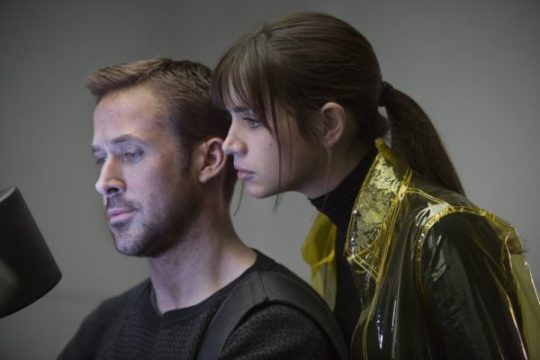
K has a live-in hologram named Joi (Ana de Armas), a manic pixie dream AI who’s there to soothe K’s brow and tell him he’s loved and parade around the apartment in an assortment of sexy get-ups. The spelling of her name can’t be accidental. In certain corners of the Internet, JOI is an acronym for Jerk Off Instruction, where scantily-clad females whisper sweet nothings at you until you, er, interface.
Joi’s a one-note character but here’s the thing: their relationship is by far the most interesting thing in the film. Can a robot and an operating system get it on? Thanks to a hooker with a heart of gold (Mackenzie Davis as a Discount Pris), they can in one of the year’s weirdest, sexily unsexy sex scenes that owes a little something to a similar moment in Spike Jonze’s Her.
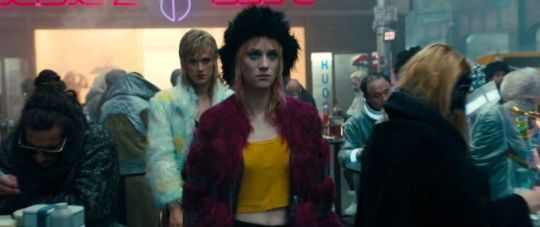
K doesn’t have a proper name, just a serial number, and he’s caught in a paranoid nightmare, in part because – unlike his predecessor Deckard who just grudgingly went about his job and then drank to forget, only to realise at the end of Blade Runner that something was amiss – he feels he’s something special. He’s haunted by a childhood memory and wonders what life would be like if he had a soul. Someone later christens him Joe, as in Kafka’s The Trial.
There’s another literary reference buried in the plot. Following each kill, K is required to undergo a ‘baseline test’ in which he has to repeat random gibberish that sounds like garbled poetry. That’s because it is – specifically, it’s a mash-up of these lines from Nabokov’s Pale Fire, which just happens to be K’s favourite book:
Cells interlinked within cells interlinked
Within one stem. And dreadfully distinct
Against the dark, a tall white fountain played
Not having read Nabokov’s book, I cannot say if this is important for the plot or if it’s just cool-sounding stuff; screenwriters always like to throw poetry into scripts because it sounds classy. David Webb Peoples had Roy Batty quoting Milton.
Speaking of Peoples, I’d be curious to know why he wasn’t involved in the script for Blade Runner 2049. The sequel does feel very much like the film that Fancher originally wanted to make all those years ago (the opening sequence was supposed to have been the opening scene of the original film), and while I’m glad that Fancher has expanded the world of Blade Runner to show us life outside Los Angeles, there is something both a little precious and a little corny in some of its story elements, and perhaps if Peoples had taken a pass at the script, he could have tightened it up much as he did the original.
I haven’t even got to Harrison Ford’s return, which comes late, and provides a slow-moving film a jolt of energy, even if it’s a bit weird to see Deckard dressed like he’s about to do a bit of weekend gardening.

Nor have I mentioned Leto much. As the film’s nominal villain, he’s given to talking in clipped tones and seems like he’s auditioning for a quirky Bond villain. You can get a flavour of it here in a short film set prior to the events of Blade Runner 2049.
Blade Runner 2049 has opened to astonishing reviews (“instant classic”, “a modern masterpiece” etc.) and poor box-office. If it doesn’t perform well in cinemas in the next few weeks, it will be a certified bomb.
That would be a shame. Blade Runner 2049 is a visual treat and deserves to be seen on a big screen (and in a cinema with decent sound – the sound and music are amazing). In terms of big, broad spectacles, Oscars race has just narrowed to this and Dunkirk.
Verdict: Four Cells Interlinked out of Five
Enjoy some of these gorgeous stills showcasing Roger Deakins’s work.
.
Special K: Blade Runner 2049 We live in an age of sequels, of brainless blockbuster movie franchises that follow a simple template: if a movie is wildly successful, just do the same thing again but noisier.
#Blade Runner#Denis Villeneuve#Dystopia#Hans Zimmer#Harrison Ford#Johan Johansson#los angeles#Philip K. Dick#Replicants#Ridley Scott#Ryan Gosling
0 notes